Critical Analysis of Development Paradigm with Empirical Case Study
VerifiedAdded on 2023/05/30
|11
|3134
|485
Essay
AI Summary
This essay critically examines the current development paradigm and its shortcomings in assisting developing countries, arguing for its modification or change. It highlights flaws such as prioritizing economic growth over social objectives, over-reliance on exports, and fostering competition among nations. The essay supports its arguments using the empirical case of Australian aid to Indonesia, analyzing the complexities and uneven development outcomes despite foreign assistance. The analysis reveals issues with trade regulations, fluctuating currency values, and conflicting motives between donor and recipient countries. Ultimately, the essay concludes that a shift in the development paradigm is necessary to address persistent challenges like poverty, health disparities, and environmental degradation in developing nations, emphasizing the need for genuine political will and a more equitable approach to international aid and development.
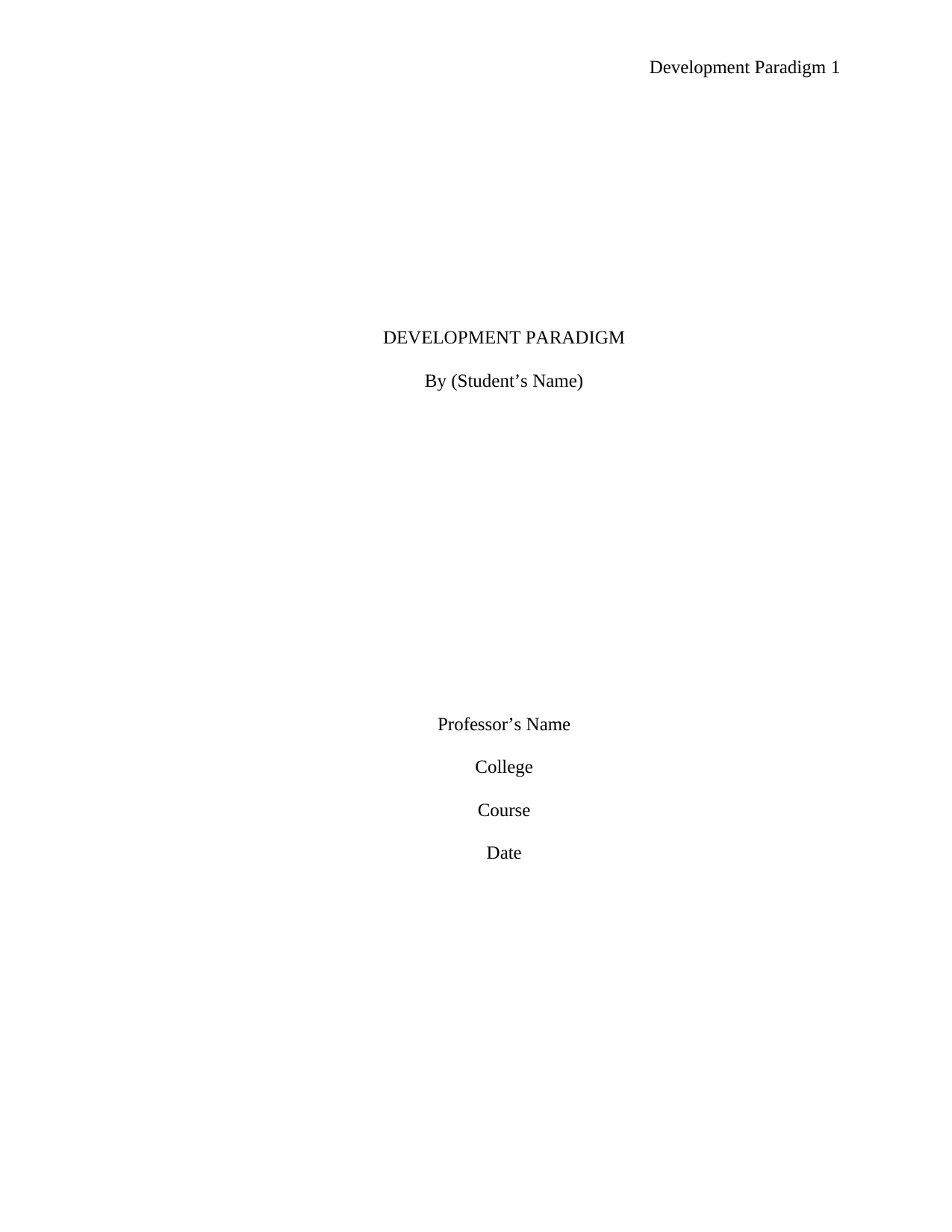
Development Paradigm 1
DEVELOPMENT PARADIGM
By (Student’s Name)
Professor’s Name
College
Course
Date
DEVELOPMENT PARADIGM
By (Student’s Name)
Professor’s Name
College
Course
Date
Secure Best Marks with AI Grader
Need help grading? Try our AI Grader for instant feedback on your assignments.
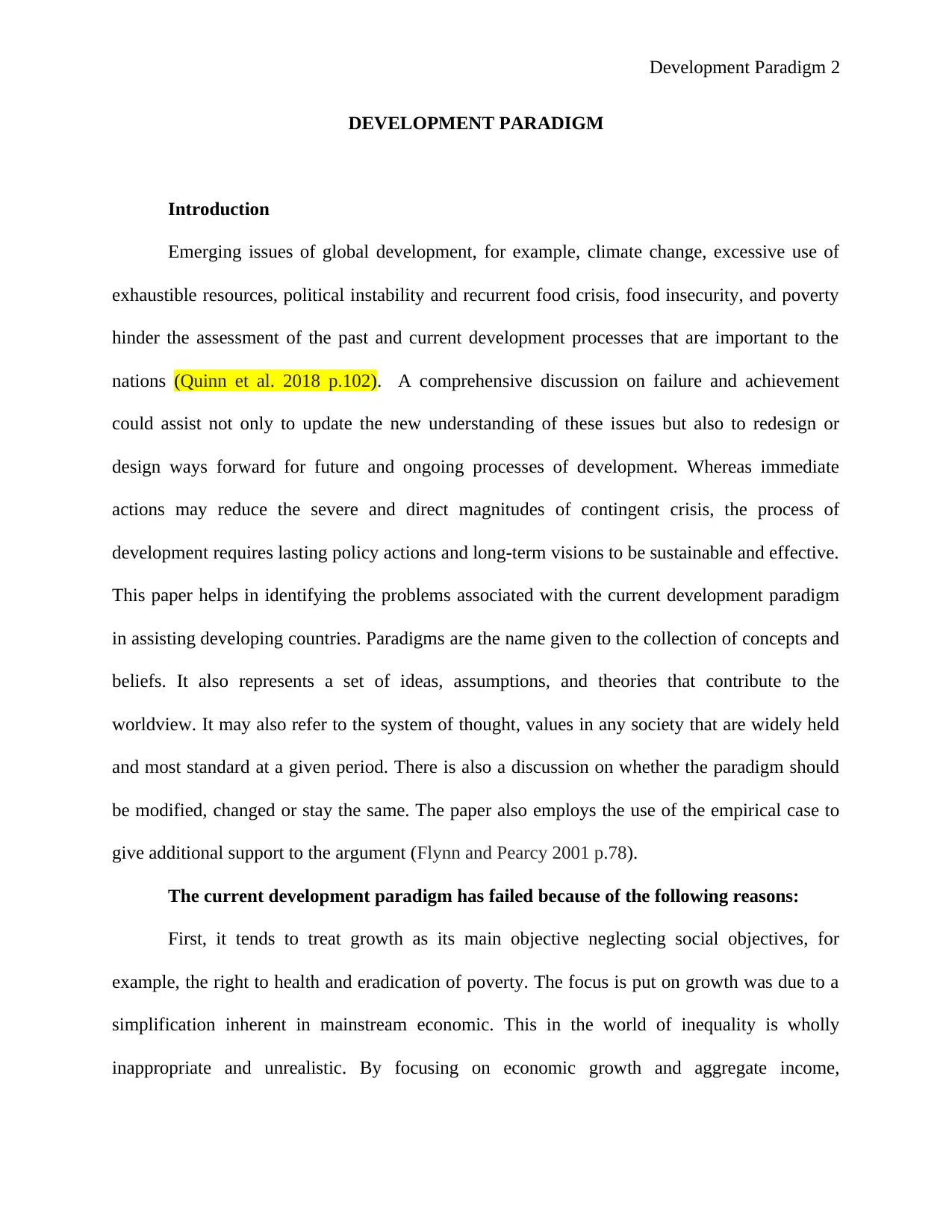
Development Paradigm 2
DEVELOPMENT PARADIGM
Introduction
Emerging issues of global development, for example, climate change, excessive use of
exhaustible resources, political instability and recurrent food crisis, food insecurity, and poverty
hinder the assessment of the past and current development processes that are important to the
nations (Quinn et al. 2018 p.102). A comprehensive discussion on failure and achievement
could assist not only to update the new understanding of these issues but also to redesign or
design ways forward for future and ongoing processes of development. Whereas immediate
actions may reduce the severe and direct magnitudes of contingent crisis, the process of
development requires lasting policy actions and long-term visions to be sustainable and effective.
This paper helps in identifying the problems associated with the current development paradigm
in assisting developing countries. Paradigms are the name given to the collection of concepts and
beliefs. It also represents a set of ideas, assumptions, and theories that contribute to the
worldview. It may also refer to the system of thought, values in any society that are widely held
and most standard at a given period. There is also a discussion on whether the paradigm should
be modified, changed or stay the same. The paper also employs the use of the empirical case to
give additional support to the argument (Flynn and Pearcy 2001 p.78).
The current development paradigm has failed because of the following reasons:
First, it tends to treat growth as its main objective neglecting social objectives, for
example, the right to health and eradication of poverty. The focus is put on growth was due to a
simplification inherent in mainstream economic. This in the world of inequality is wholly
inappropriate and unrealistic. By focusing on economic growth and aggregate income,
DEVELOPMENT PARADIGM
Introduction
Emerging issues of global development, for example, climate change, excessive use of
exhaustible resources, political instability and recurrent food crisis, food insecurity, and poverty
hinder the assessment of the past and current development processes that are important to the
nations (Quinn et al. 2018 p.102). A comprehensive discussion on failure and achievement
could assist not only to update the new understanding of these issues but also to redesign or
design ways forward for future and ongoing processes of development. Whereas immediate
actions may reduce the severe and direct magnitudes of contingent crisis, the process of
development requires lasting policy actions and long-term visions to be sustainable and effective.
This paper helps in identifying the problems associated with the current development paradigm
in assisting developing countries. Paradigms are the name given to the collection of concepts and
beliefs. It also represents a set of ideas, assumptions, and theories that contribute to the
worldview. It may also refer to the system of thought, values in any society that are widely held
and most standard at a given period. There is also a discussion on whether the paradigm should
be modified, changed or stay the same. The paper also employs the use of the empirical case to
give additional support to the argument (Flynn and Pearcy 2001 p.78).
The current development paradigm has failed because of the following reasons:
First, it tends to treat growth as its main objective neglecting social objectives, for
example, the right to health and eradication of poverty. The focus is put on growth was due to a
simplification inherent in mainstream economic. This in the world of inequality is wholly
inappropriate and unrealistic. By focusing on economic growth and aggregate income,
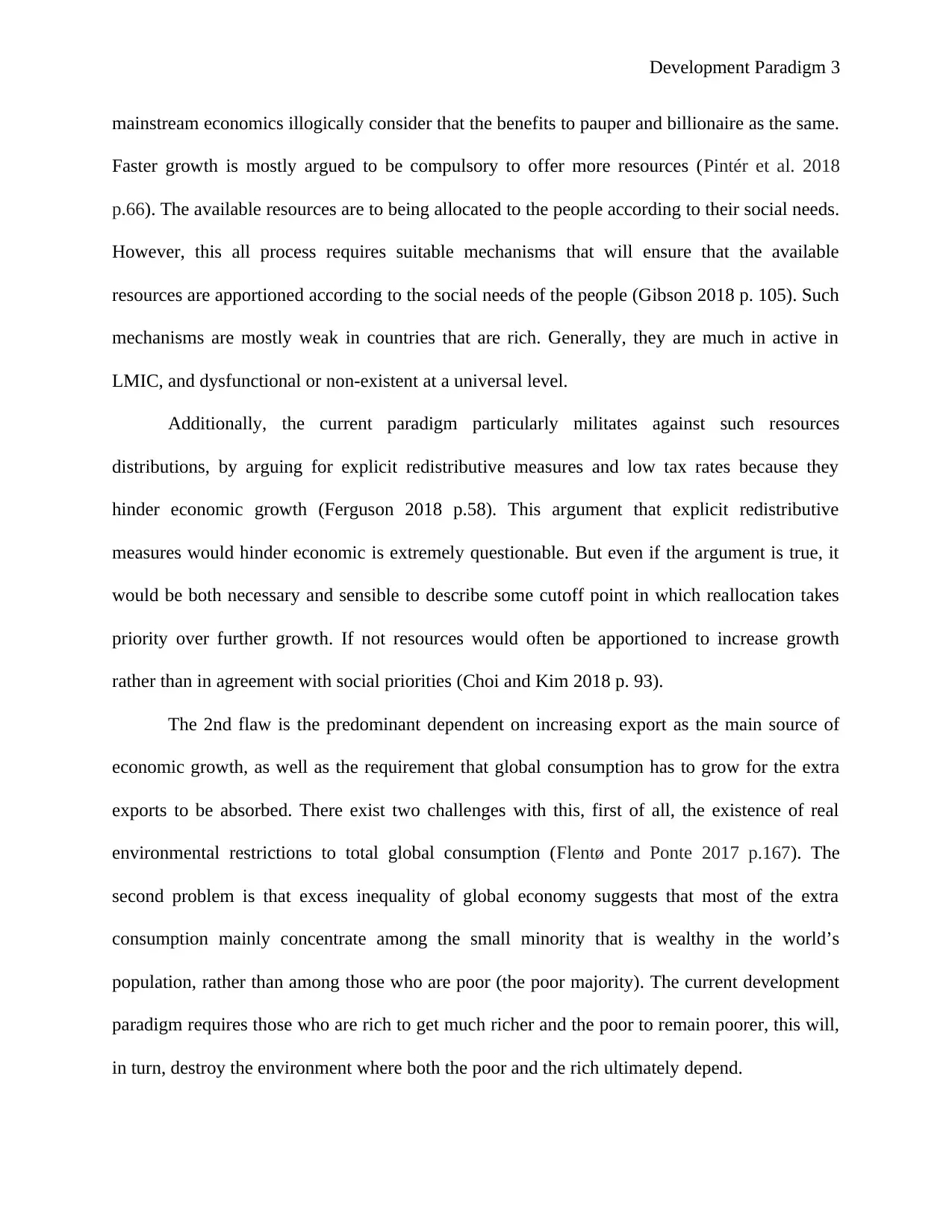
Development Paradigm 3
mainstream economics illogically consider that the benefits to pauper and billionaire as the same.
Faster growth is mostly argued to be compulsory to offer more resources (Pintér et al. 2018
p.66). The available resources are to being allocated to the people according to their social needs.
However, this all process requires suitable mechanisms that will ensure that the available
resources are apportioned according to the social needs of the people (Gibson 2018 p. 105). Such
mechanisms are mostly weak in countries that are rich. Generally, they are much in active in
LMIC, and dysfunctional or non-existent at a universal level.
Additionally, the current paradigm particularly militates against such resources
distributions, by arguing for explicit redistributive measures and low tax rates because they
hinder economic growth (Ferguson 2018 p.58). This argument that explicit redistributive
measures would hinder economic is extremely questionable. But even if the argument is true, it
would be both necessary and sensible to describe some cutoff point in which reallocation takes
priority over further growth. If not resources would often be apportioned to increase growth
rather than in agreement with social priorities (Choi and Kim 2018 p. 93).
The 2nd flaw is the predominant dependent on increasing export as the main source of
economic growth, as well as the requirement that global consumption has to grow for the extra
exports to be absorbed. There exist two challenges with this, first of all, the existence of real
environmental restrictions to total global consumption (Flentø and Ponte 2017 p.167). The
second problem is that excess inequality of global economy suggests that most of the extra
consumption mainly concentrate among the small minority that is wealthy in the world’s
population, rather than among those who are poor (the poor majority). The current development
paradigm requires those who are rich to get much richer and the poor to remain poorer, this will,
in turn, destroy the environment where both the poor and the rich ultimately depend.
mainstream economics illogically consider that the benefits to pauper and billionaire as the same.
Faster growth is mostly argued to be compulsory to offer more resources (Pintér et al. 2018
p.66). The available resources are to being allocated to the people according to their social needs.
However, this all process requires suitable mechanisms that will ensure that the available
resources are apportioned according to the social needs of the people (Gibson 2018 p. 105). Such
mechanisms are mostly weak in countries that are rich. Generally, they are much in active in
LMIC, and dysfunctional or non-existent at a universal level.
Additionally, the current paradigm particularly militates against such resources
distributions, by arguing for explicit redistributive measures and low tax rates because they
hinder economic growth (Ferguson 2018 p.58). This argument that explicit redistributive
measures would hinder economic is extremely questionable. But even if the argument is true, it
would be both necessary and sensible to describe some cutoff point in which reallocation takes
priority over further growth. If not resources would often be apportioned to increase growth
rather than in agreement with social priorities (Choi and Kim 2018 p. 93).
The 2nd flaw is the predominant dependent on increasing export as the main source of
economic growth, as well as the requirement that global consumption has to grow for the extra
exports to be absorbed. There exist two challenges with this, first of all, the existence of real
environmental restrictions to total global consumption (Flentø and Ponte 2017 p.167). The
second problem is that excess inequality of global economy suggests that most of the extra
consumption mainly concentrate among the small minority that is wealthy in the world’s
population, rather than among those who are poor (the poor majority). The current development
paradigm requires those who are rich to get much richer and the poor to remain poorer, this will,
in turn, destroy the environment where both the poor and the rich ultimately depend.
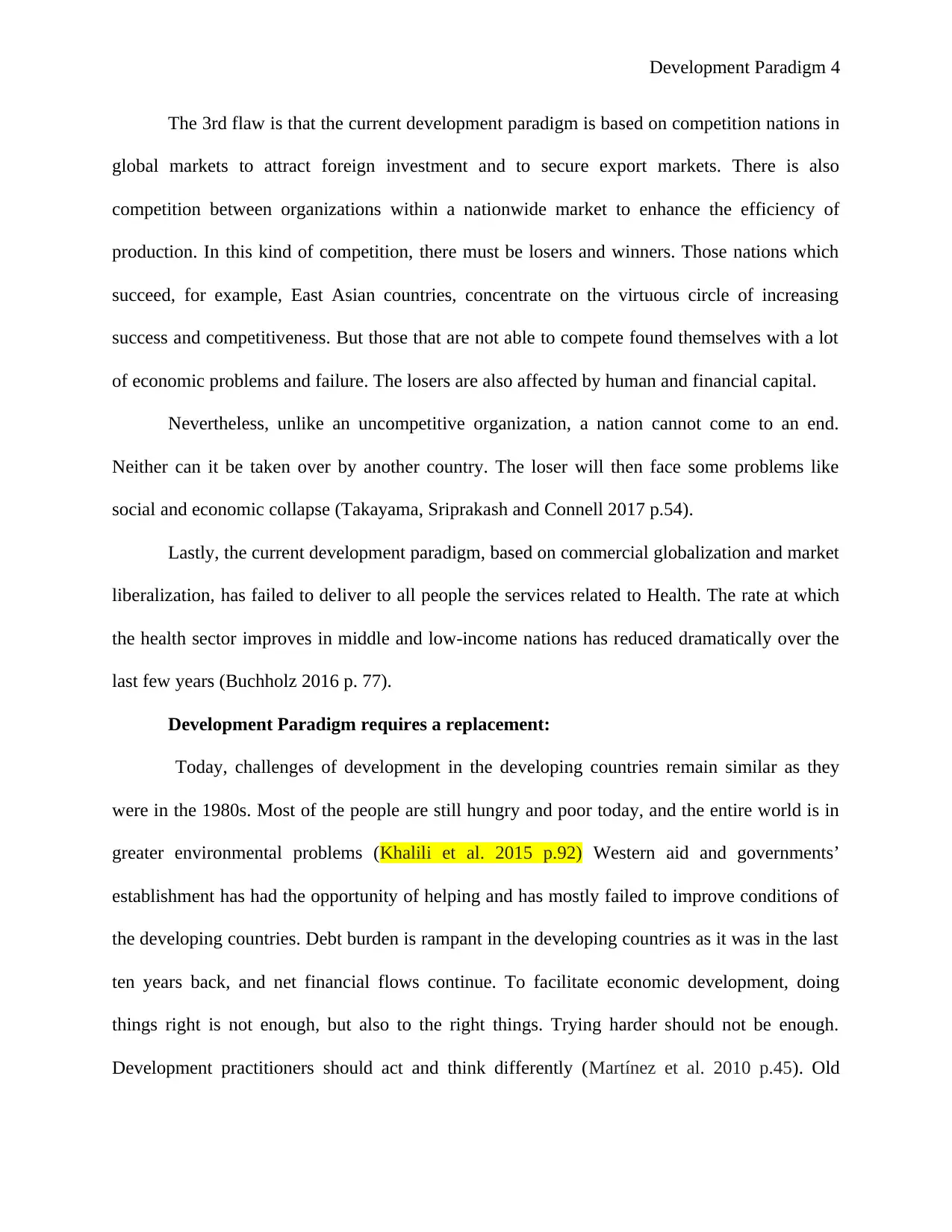
Development Paradigm 4
The 3rd flaw is that the current development paradigm is based on competition nations in
global markets to attract foreign investment and to secure export markets. There is also
competition between organizations within a nationwide market to enhance the efficiency of
production. In this kind of competition, there must be losers and winners. Those nations which
succeed, for example, East Asian countries, concentrate on the virtuous circle of increasing
success and competitiveness. But those that are not able to compete found themselves with a lot
of economic problems and failure. The losers are also affected by human and financial capital.
Nevertheless, unlike an uncompetitive organization, a nation cannot come to an end.
Neither can it be taken over by another country. The loser will then face some problems like
social and economic collapse (Takayama, Sriprakash and Connell 2017 p.54).
Lastly, the current development paradigm, based on commercial globalization and market
liberalization, has failed to deliver to all people the services related to Health. The rate at which
the health sector improves in middle and low-income nations has reduced dramatically over the
last few years (Buchholz 2016 p. 77).
Development Paradigm requires a replacement:
Today, challenges of development in the developing countries remain similar as they
were in the 1980s. Most of the people are still hungry and poor today, and the entire world is in
greater environmental problems (Khalili et al. 2015 p.92) Western aid and governments’
establishment has had the opportunity of helping and has mostly failed to improve conditions of
the developing countries. Debt burden is rampant in the developing countries as it was in the last
ten years back, and net financial flows continue. To facilitate economic development, doing
things right is not enough, but also to the right things. Trying harder should not be enough.
Development practitioners should act and think differently (Martínez et al. 2010 p.45). Old
The 3rd flaw is that the current development paradigm is based on competition nations in
global markets to attract foreign investment and to secure export markets. There is also
competition between organizations within a nationwide market to enhance the efficiency of
production. In this kind of competition, there must be losers and winners. Those nations which
succeed, for example, East Asian countries, concentrate on the virtuous circle of increasing
success and competitiveness. But those that are not able to compete found themselves with a lot
of economic problems and failure. The losers are also affected by human and financial capital.
Nevertheless, unlike an uncompetitive organization, a nation cannot come to an end.
Neither can it be taken over by another country. The loser will then face some problems like
social and economic collapse (Takayama, Sriprakash and Connell 2017 p.54).
Lastly, the current development paradigm, based on commercial globalization and market
liberalization, has failed to deliver to all people the services related to Health. The rate at which
the health sector improves in middle and low-income nations has reduced dramatically over the
last few years (Buchholz 2016 p. 77).
Development Paradigm requires a replacement:
Today, challenges of development in the developing countries remain similar as they
were in the 1980s. Most of the people are still hungry and poor today, and the entire world is in
greater environmental problems (Khalili et al. 2015 p.92) Western aid and governments’
establishment has had the opportunity of helping and has mostly failed to improve conditions of
the developing countries. Debt burden is rampant in the developing countries as it was in the last
ten years back, and net financial flows continue. To facilitate economic development, doing
things right is not enough, but also to the right things. Trying harder should not be enough.
Development practitioners should act and think differently (Martínez et al. 2010 p.45). Old
Secure Best Marks with AI Grader
Need help grading? Try our AI Grader for instant feedback on your assignments.
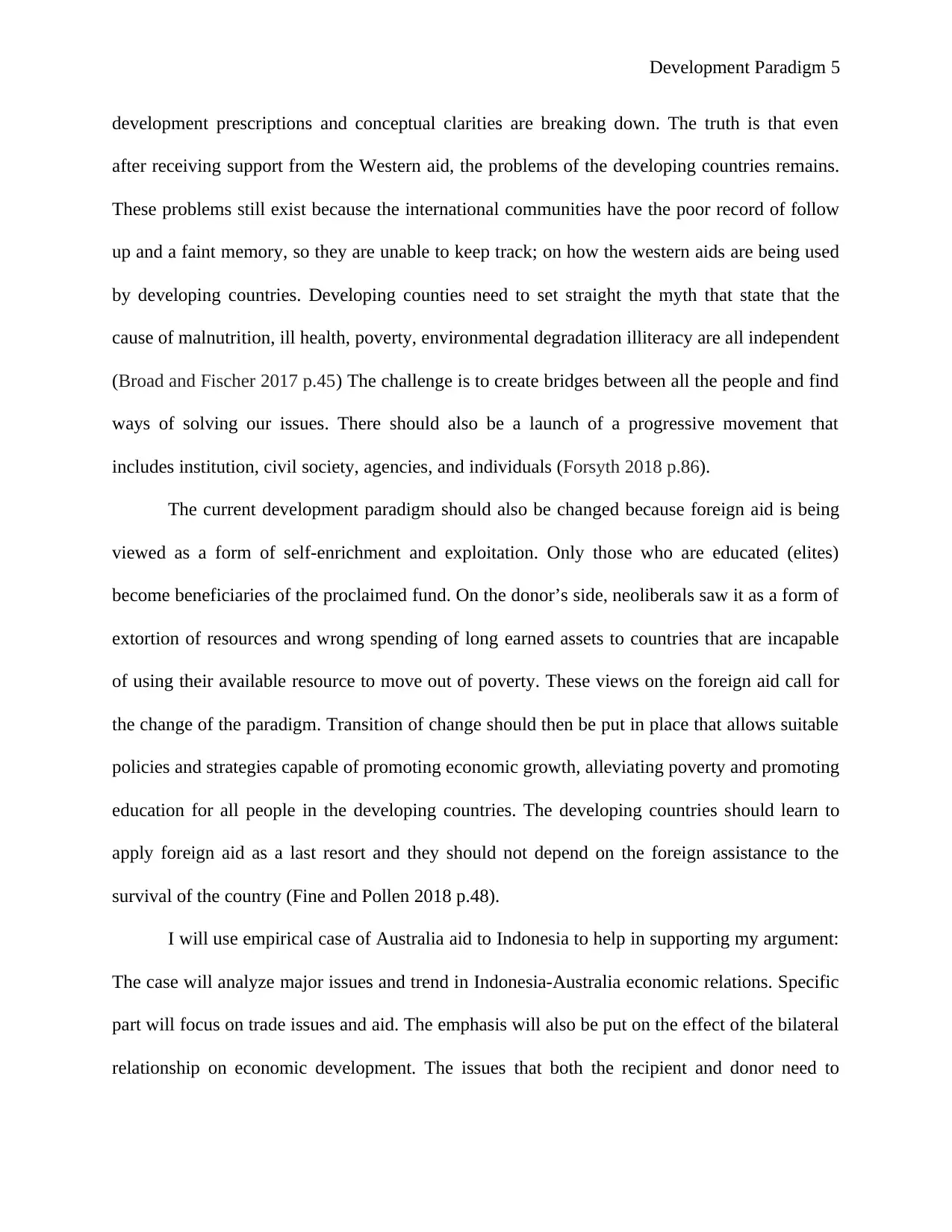
Development Paradigm 5
development prescriptions and conceptual clarities are breaking down. The truth is that even
after receiving support from the Western aid, the problems of the developing countries remains.
These problems still exist because the international communities have the poor record of follow
up and a faint memory, so they are unable to keep track; on how the western aids are being used
by developing countries. Developing counties need to set straight the myth that state that the
cause of malnutrition, ill health, poverty, environmental degradation illiteracy are all independent
(Broad and Fischer 2017 p.45) The challenge is to create bridges between all the people and find
ways of solving our issues. There should also be a launch of a progressive movement that
includes institution, civil society, agencies, and individuals (Forsyth 2018 p.86).
The current development paradigm should also be changed because foreign aid is being
viewed as a form of self-enrichment and exploitation. Only those who are educated (elites)
become beneficiaries of the proclaimed fund. On the donor’s side, neoliberals saw it as a form of
extortion of resources and wrong spending of long earned assets to countries that are incapable
of using their available resource to move out of poverty. These views on the foreign aid call for
the change of the paradigm. Transition of change should then be put in place that allows suitable
policies and strategies capable of promoting economic growth, alleviating poverty and promoting
education for all people in the developing countries. The developing countries should learn to
apply foreign aid as a last resort and they should not depend on the foreign assistance to the
survival of the country (Fine and Pollen 2018 p.48).
I will use empirical case of Australia aid to Indonesia to help in supporting my argument:
The case will analyze major issues and trend in Indonesia-Australia economic relations. Specific
part will focus on trade issues and aid. The emphasis will also be put on the effect of the bilateral
relationship on economic development. The issues that both the recipient and donor need to
development prescriptions and conceptual clarities are breaking down. The truth is that even
after receiving support from the Western aid, the problems of the developing countries remains.
These problems still exist because the international communities have the poor record of follow
up and a faint memory, so they are unable to keep track; on how the western aids are being used
by developing countries. Developing counties need to set straight the myth that state that the
cause of malnutrition, ill health, poverty, environmental degradation illiteracy are all independent
(Broad and Fischer 2017 p.45) The challenge is to create bridges between all the people and find
ways of solving our issues. There should also be a launch of a progressive movement that
includes institution, civil society, agencies, and individuals (Forsyth 2018 p.86).
The current development paradigm should also be changed because foreign aid is being
viewed as a form of self-enrichment and exploitation. Only those who are educated (elites)
become beneficiaries of the proclaimed fund. On the donor’s side, neoliberals saw it as a form of
extortion of resources and wrong spending of long earned assets to countries that are incapable
of using their available resource to move out of poverty. These views on the foreign aid call for
the change of the paradigm. Transition of change should then be put in place that allows suitable
policies and strategies capable of promoting economic growth, alleviating poverty and promoting
education for all people in the developing countries. The developing countries should learn to
apply foreign aid as a last resort and they should not depend on the foreign assistance to the
survival of the country (Fine and Pollen 2018 p.48).
I will use empirical case of Australia aid to Indonesia to help in supporting my argument:
The case will analyze major issues and trend in Indonesia-Australia economic relations. Specific
part will focus on trade issues and aid. The emphasis will also be put on the effect of the bilateral
relationship on economic development. The issues that both the recipient and donor need to
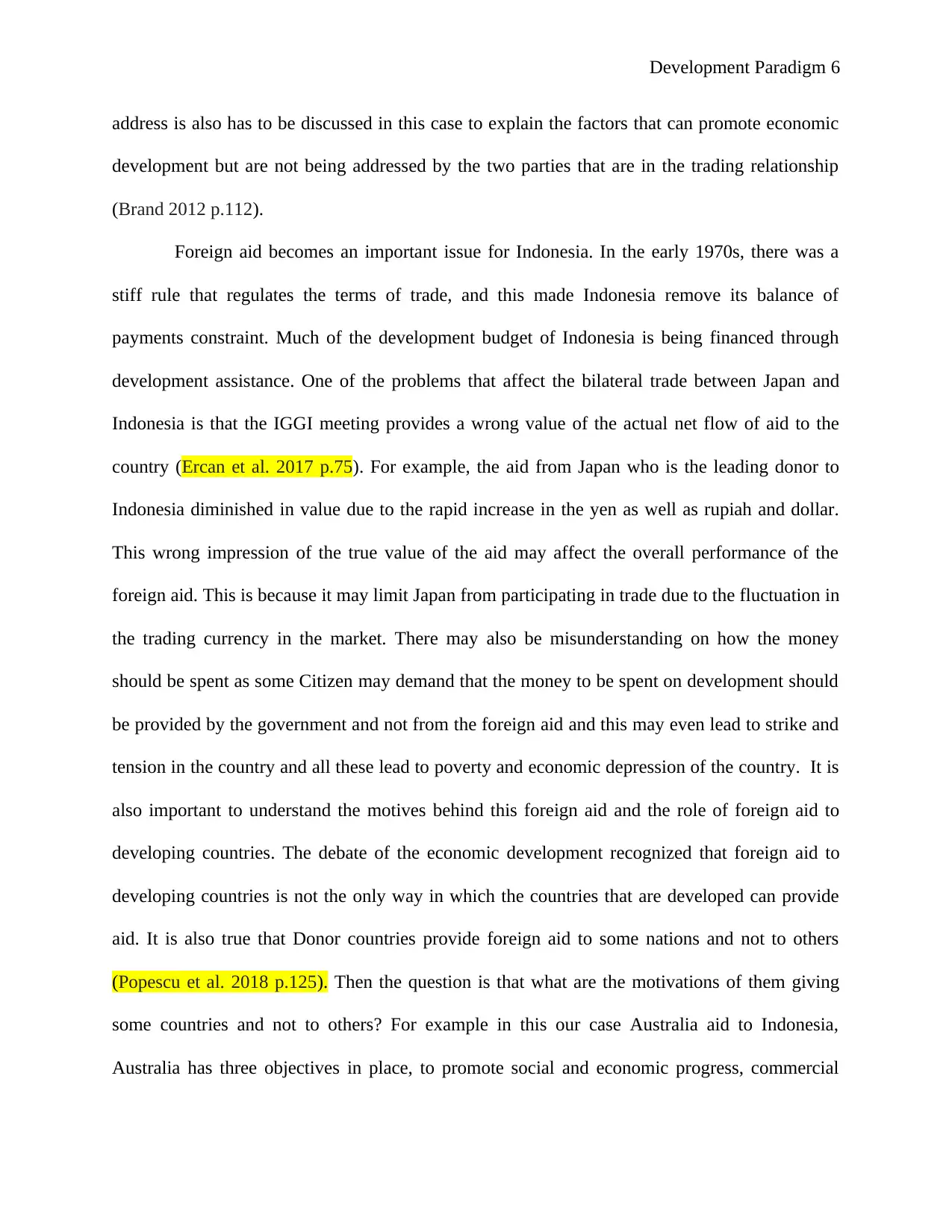
Development Paradigm 6
address is also has to be discussed in this case to explain the factors that can promote economic
development but are not being addressed by the two parties that are in the trading relationship
(Brand 2012 p.112).
Foreign aid becomes an important issue for Indonesia. In the early 1970s, there was a
stiff rule that regulates the terms of trade, and this made Indonesia remove its balance of
payments constraint. Much of the development budget of Indonesia is being financed through
development assistance. One of the problems that affect the bilateral trade between Japan and
Indonesia is that the IGGI meeting provides a wrong value of the actual net flow of aid to the
country (Ercan et al. 2017 p.75). For example, the aid from Japan who is the leading donor to
Indonesia diminished in value due to the rapid increase in the yen as well as rupiah and dollar.
This wrong impression of the true value of the aid may affect the overall performance of the
foreign aid. This is because it may limit Japan from participating in trade due to the fluctuation in
the trading currency in the market. There may also be misunderstanding on how the money
should be spent as some Citizen may demand that the money to be spent on development should
be provided by the government and not from the foreign aid and this may even lead to strike and
tension in the country and all these lead to poverty and economic depression of the country. It is
also important to understand the motives behind this foreign aid and the role of foreign aid to
developing countries. The debate of the economic development recognized that foreign aid to
developing countries is not the only way in which the countries that are developed can provide
aid. It is also true that Donor countries provide foreign aid to some nations and not to others
(Popescu et al. 2018 p.125). Then the question is that what are the motivations of them giving
some countries and not to others? For example in this our case Australia aid to Indonesia,
Australia has three objectives in place, to promote social and economic progress, commercial
address is also has to be discussed in this case to explain the factors that can promote economic
development but are not being addressed by the two parties that are in the trading relationship
(Brand 2012 p.112).
Foreign aid becomes an important issue for Indonesia. In the early 1970s, there was a
stiff rule that regulates the terms of trade, and this made Indonesia remove its balance of
payments constraint. Much of the development budget of Indonesia is being financed through
development assistance. One of the problems that affect the bilateral trade between Japan and
Indonesia is that the IGGI meeting provides a wrong value of the actual net flow of aid to the
country (Ercan et al. 2017 p.75). For example, the aid from Japan who is the leading donor to
Indonesia diminished in value due to the rapid increase in the yen as well as rupiah and dollar.
This wrong impression of the true value of the aid may affect the overall performance of the
foreign aid. This is because it may limit Japan from participating in trade due to the fluctuation in
the trading currency in the market. There may also be misunderstanding on how the money
should be spent as some Citizen may demand that the money to be spent on development should
be provided by the government and not from the foreign aid and this may even lead to strike and
tension in the country and all these lead to poverty and economic depression of the country. It is
also important to understand the motives behind this foreign aid and the role of foreign aid to
developing countries. The debate of the economic development recognized that foreign aid to
developing countries is not the only way in which the countries that are developed can provide
aid. It is also true that Donor countries provide foreign aid to some nations and not to others
(Popescu et al. 2018 p.125). Then the question is that what are the motivations of them giving
some countries and not to others? For example in this our case Australia aid to Indonesia,
Australia has three objectives in place, to promote social and economic progress, commercial
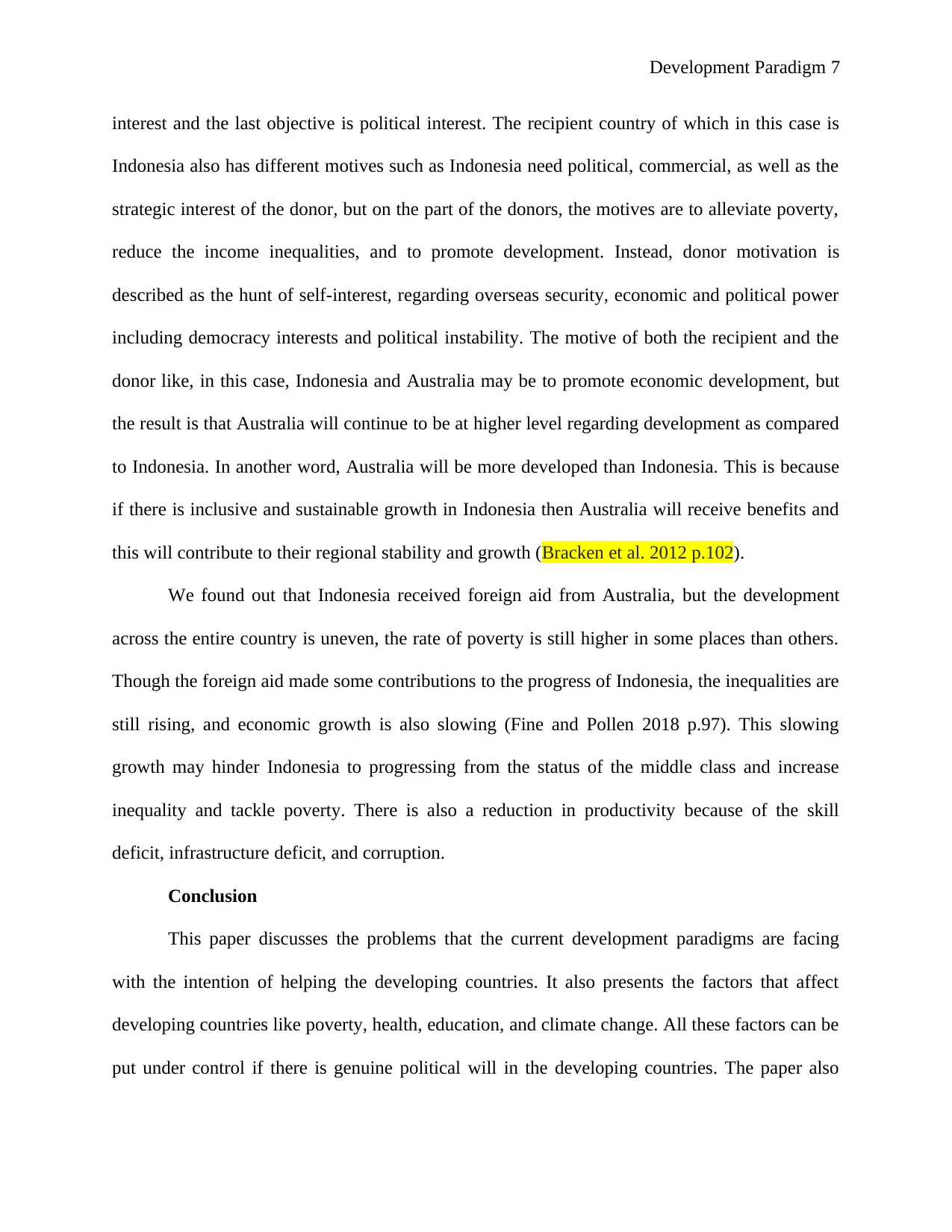
Development Paradigm 7
interest and the last objective is political interest. The recipient country of which in this case is
Indonesia also has different motives such as Indonesia need political, commercial, as well as the
strategic interest of the donor, but on the part of the donors, the motives are to alleviate poverty,
reduce the income inequalities, and to promote development. Instead, donor motivation is
described as the hunt of self-interest, regarding overseas security, economic and political power
including democracy interests and political instability. The motive of both the recipient and the
donor like, in this case, Indonesia and Australia may be to promote economic development, but
the result is that Australia will continue to be at higher level regarding development as compared
to Indonesia. In another word, Australia will be more developed than Indonesia. This is because
if there is inclusive and sustainable growth in Indonesia then Australia will receive benefits and
this will contribute to their regional stability and growth (Bracken et al. 2012 p.102).
We found out that Indonesia received foreign aid from Australia, but the development
across the entire country is uneven, the rate of poverty is still higher in some places than others.
Though the foreign aid made some contributions to the progress of Indonesia, the inequalities are
still rising, and economic growth is also slowing (Fine and Pollen 2018 p.97). This slowing
growth may hinder Indonesia to progressing from the status of the middle class and increase
inequality and tackle poverty. There is also a reduction in productivity because of the skill
deficit, infrastructure deficit, and corruption.
Conclusion
This paper discusses the problems that the current development paradigms are facing
with the intention of helping the developing countries. It also presents the factors that affect
developing countries like poverty, health, education, and climate change. All these factors can be
put under control if there is genuine political will in the developing countries. The paper also
interest and the last objective is political interest. The recipient country of which in this case is
Indonesia also has different motives such as Indonesia need political, commercial, as well as the
strategic interest of the donor, but on the part of the donors, the motives are to alleviate poverty,
reduce the income inequalities, and to promote development. Instead, donor motivation is
described as the hunt of self-interest, regarding overseas security, economic and political power
including democracy interests and political instability. The motive of both the recipient and the
donor like, in this case, Indonesia and Australia may be to promote economic development, but
the result is that Australia will continue to be at higher level regarding development as compared
to Indonesia. In another word, Australia will be more developed than Indonesia. This is because
if there is inclusive and sustainable growth in Indonesia then Australia will receive benefits and
this will contribute to their regional stability and growth (Bracken et al. 2012 p.102).
We found out that Indonesia received foreign aid from Australia, but the development
across the entire country is uneven, the rate of poverty is still higher in some places than others.
Though the foreign aid made some contributions to the progress of Indonesia, the inequalities are
still rising, and economic growth is also slowing (Fine and Pollen 2018 p.97). This slowing
growth may hinder Indonesia to progressing from the status of the middle class and increase
inequality and tackle poverty. There is also a reduction in productivity because of the skill
deficit, infrastructure deficit, and corruption.
Conclusion
This paper discusses the problems that the current development paradigms are facing
with the intention of helping the developing countries. It also presents the factors that affect
developing countries like poverty, health, education, and climate change. All these factors can be
put under control if there is genuine political will in the developing countries. The paper also
Paraphrase This Document
Need a fresh take? Get an instant paraphrase of this document with our AI Paraphraser
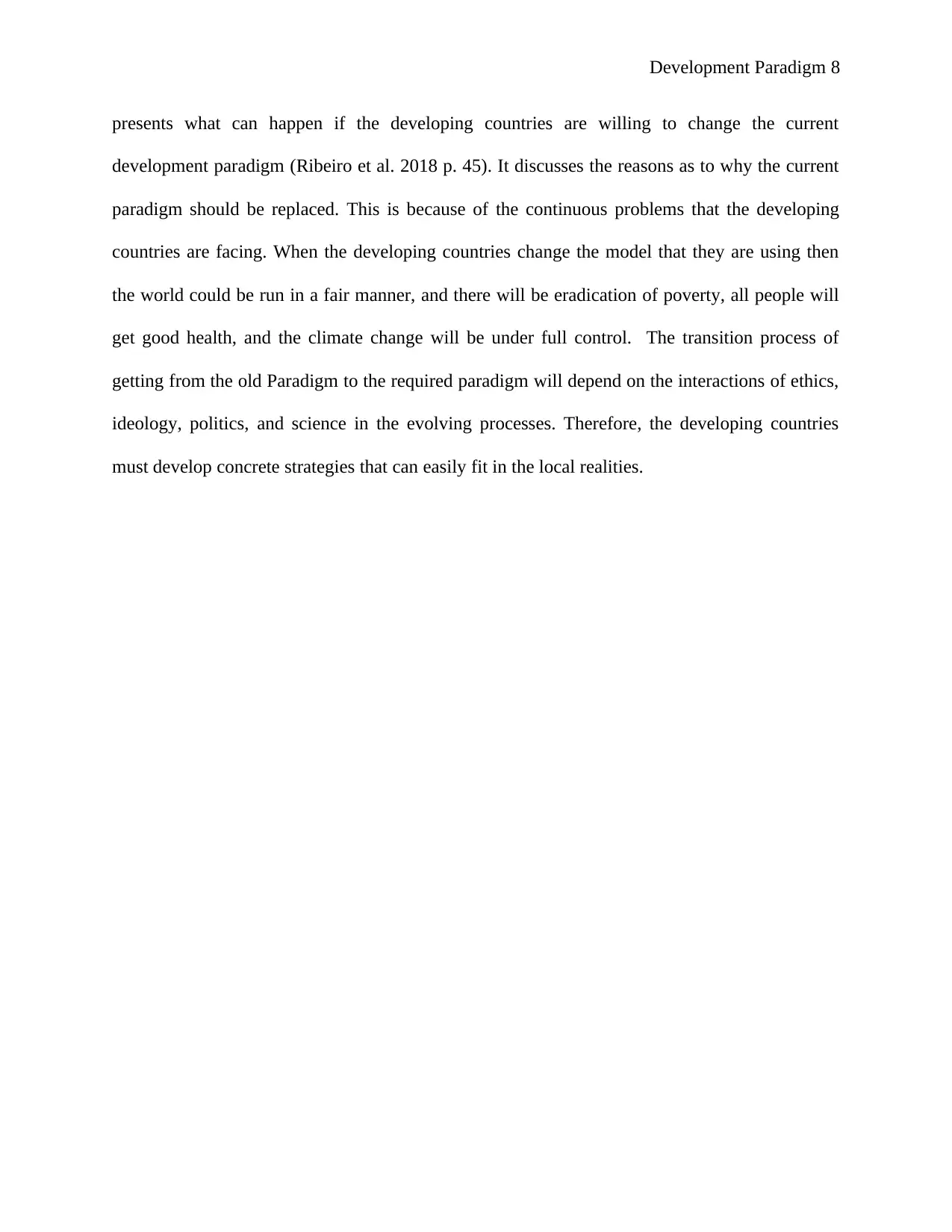
Development Paradigm 8
presents what can happen if the developing countries are willing to change the current
development paradigm (Ribeiro et al. 2018 p. 45). It discusses the reasons as to why the current
paradigm should be replaced. This is because of the continuous problems that the developing
countries are facing. When the developing countries change the model that they are using then
the world could be run in a fair manner, and there will be eradication of poverty, all people will
get good health, and the climate change will be under full control. The transition process of
getting from the old Paradigm to the required paradigm will depend on the interactions of ethics,
ideology, politics, and science in the evolving processes. Therefore, the developing countries
must develop concrete strategies that can easily fit in the local realities.
presents what can happen if the developing countries are willing to change the current
development paradigm (Ribeiro et al. 2018 p. 45). It discusses the reasons as to why the current
paradigm should be replaced. This is because of the continuous problems that the developing
countries are facing. When the developing countries change the model that they are using then
the world could be run in a fair manner, and there will be eradication of poverty, all people will
get good health, and the climate change will be under full control. The transition process of
getting from the old Paradigm to the required paradigm will depend on the interactions of ethics,
ideology, politics, and science in the evolving processes. Therefore, the developing countries
must develop concrete strategies that can easily fit in the local realities.
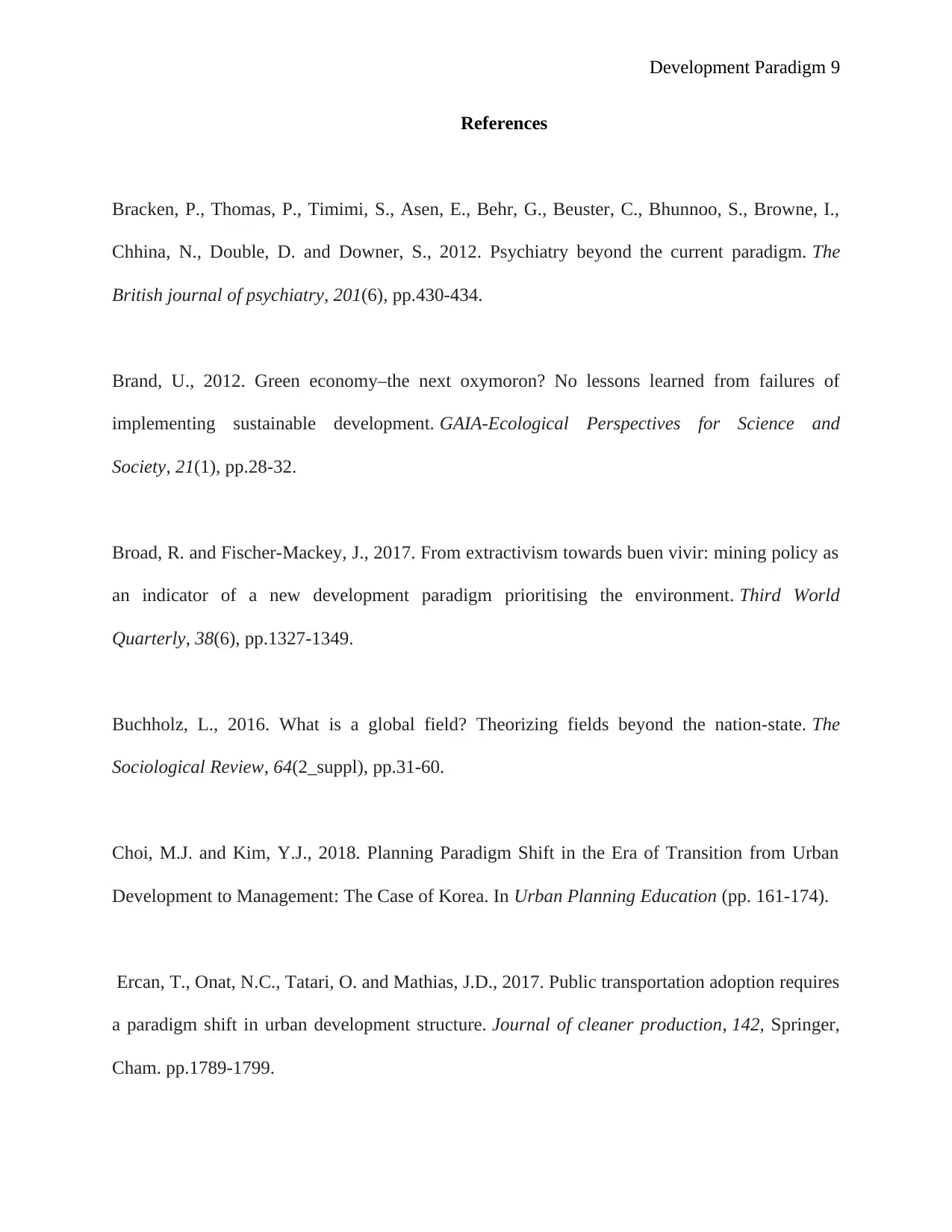
Development Paradigm 9
References
Bracken, P., Thomas, P., Timimi, S., Asen, E., Behr, G., Beuster, C., Bhunnoo, S., Browne, I.,
Chhina, N., Double, D. and Downer, S., 2012. Psychiatry beyond the current paradigm. The
British journal of psychiatry, 201(6), pp.430-434.
Brand, U., 2012. Green economy–the next oxymoron? No lessons learned from failures of
implementing sustainable development. GAIA-Ecological Perspectives for Science and
Society, 21(1), pp.28-32.
Broad, R. and Fischer-Mackey, J., 2017. From extractivism towards buen vivir: mining policy as
an indicator of a new development paradigm prioritising the environment. Third World
Quarterly, 38(6), pp.1327-1349.
Buchholz, L., 2016. What is a global field? Theorizing fields beyond the nation-state. The
Sociological Review, 64(2_suppl), pp.31-60.
Choi, M.J. and Kim, Y.J., 2018. Planning Paradigm Shift in the Era of Transition from Urban
Development to Management: The Case of Korea. In Urban Planning Education (pp. 161-174).
Ercan, T., Onat, N.C., Tatari, O. and Mathias, J.D., 2017. Public transportation adoption requires
a paradigm shift in urban development structure. Journal of cleaner production, 142, Springer,
Cham. pp.1789-1799.
References
Bracken, P., Thomas, P., Timimi, S., Asen, E., Behr, G., Beuster, C., Bhunnoo, S., Browne, I.,
Chhina, N., Double, D. and Downer, S., 2012. Psychiatry beyond the current paradigm. The
British journal of psychiatry, 201(6), pp.430-434.
Brand, U., 2012. Green economy–the next oxymoron? No lessons learned from failures of
implementing sustainable development. GAIA-Ecological Perspectives for Science and
Society, 21(1), pp.28-32.
Broad, R. and Fischer-Mackey, J., 2017. From extractivism towards buen vivir: mining policy as
an indicator of a new development paradigm prioritising the environment. Third World
Quarterly, 38(6), pp.1327-1349.
Buchholz, L., 2016. What is a global field? Theorizing fields beyond the nation-state. The
Sociological Review, 64(2_suppl), pp.31-60.
Choi, M.J. and Kim, Y.J., 2018. Planning Paradigm Shift in the Era of Transition from Urban
Development to Management: The Case of Korea. In Urban Planning Education (pp. 161-174).
Ercan, T., Onat, N.C., Tatari, O. and Mathias, J.D., 2017. Public transportation adoption requires
a paradigm shift in urban development structure. Journal of cleaner production, 142, Springer,
Cham. pp.1789-1799.
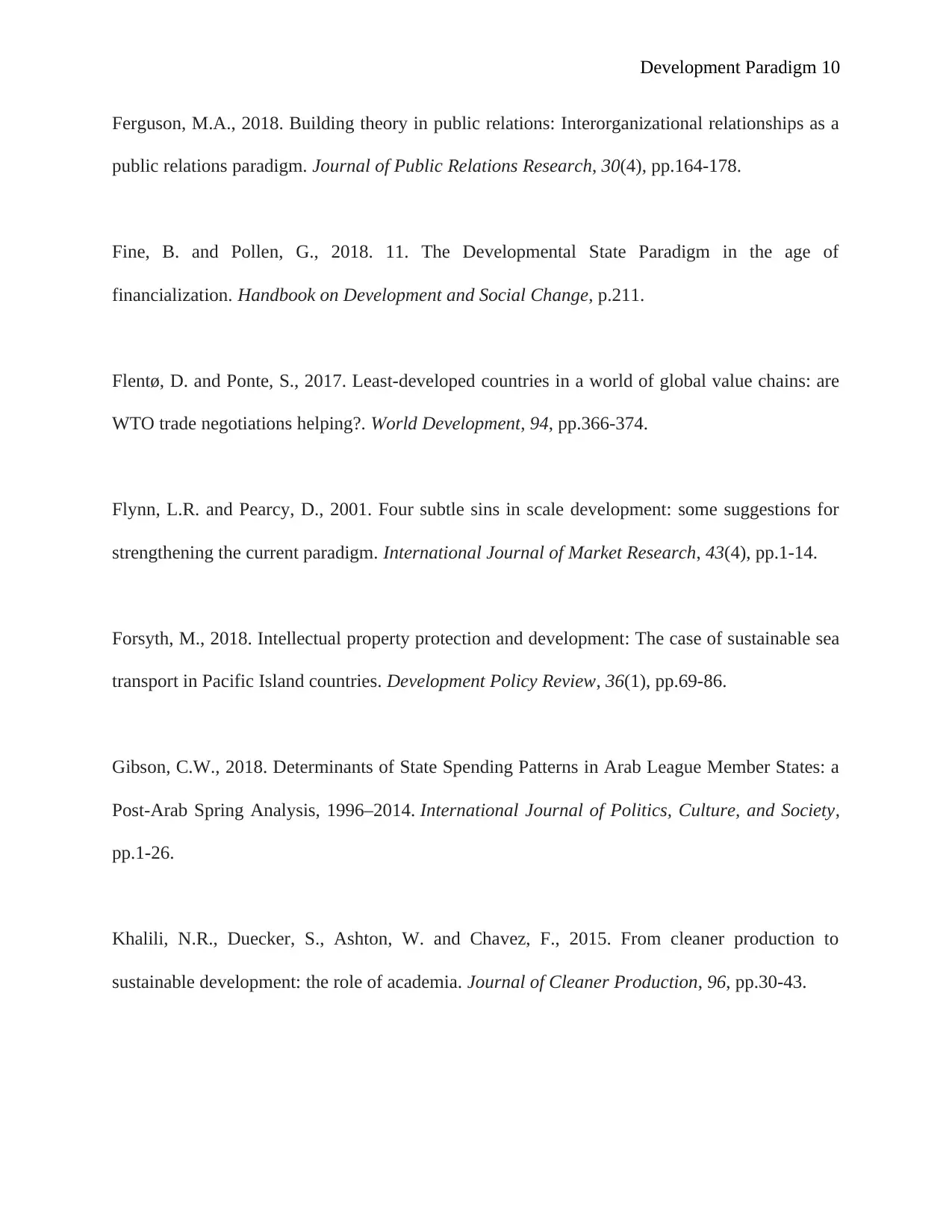
Development Paradigm 10
Ferguson, M.A., 2018. Building theory in public relations: Interorganizational relationships as a
public relations paradigm. Journal of Public Relations Research, 30(4), pp.164-178.
Fine, B. and Pollen, G., 2018. 11. The Developmental State Paradigm in the age of
financialization. Handbook on Development and Social Change, p.211.
Flentø, D. and Ponte, S., 2017. Least-developed countries in a world of global value chains: are
WTO trade negotiations helping?. World Development, 94, pp.366-374.
Flynn, L.R. and Pearcy, D., 2001. Four subtle sins in scale development: some suggestions for
strengthening the current paradigm. International Journal of Market Research, 43(4), pp.1-14.
Forsyth, M., 2018. Intellectual property protection and development: The case of sustainable sea
transport in Pacific Island countries. Development Policy Review, 36(1), pp.69-86.
Gibson, C.W., 2018. Determinants of State Spending Patterns in Arab League Member States: a
Post-Arab Spring Analysis, 1996–2014. International Journal of Politics, Culture, and Society,
pp.1-26.
Khalili, N.R., Duecker, S., Ashton, W. and Chavez, F., 2015. From cleaner production to
sustainable development: the role of academia. Journal of Cleaner Production, 96, pp.30-43.
Ferguson, M.A., 2018. Building theory in public relations: Interorganizational relationships as a
public relations paradigm. Journal of Public Relations Research, 30(4), pp.164-178.
Fine, B. and Pollen, G., 2018. 11. The Developmental State Paradigm in the age of
financialization. Handbook on Development and Social Change, p.211.
Flentø, D. and Ponte, S., 2017. Least-developed countries in a world of global value chains: are
WTO trade negotiations helping?. World Development, 94, pp.366-374.
Flynn, L.R. and Pearcy, D., 2001. Four subtle sins in scale development: some suggestions for
strengthening the current paradigm. International Journal of Market Research, 43(4), pp.1-14.
Forsyth, M., 2018. Intellectual property protection and development: The case of sustainable sea
transport in Pacific Island countries. Development Policy Review, 36(1), pp.69-86.
Gibson, C.W., 2018. Determinants of State Spending Patterns in Arab League Member States: a
Post-Arab Spring Analysis, 1996–2014. International Journal of Politics, Culture, and Society,
pp.1-26.
Khalili, N.R., Duecker, S., Ashton, W. and Chavez, F., 2015. From cleaner production to
sustainable development: the role of academia. Journal of Cleaner Production, 96, pp.30-43.
Secure Best Marks with AI Grader
Need help grading? Try our AI Grader for instant feedback on your assignments.
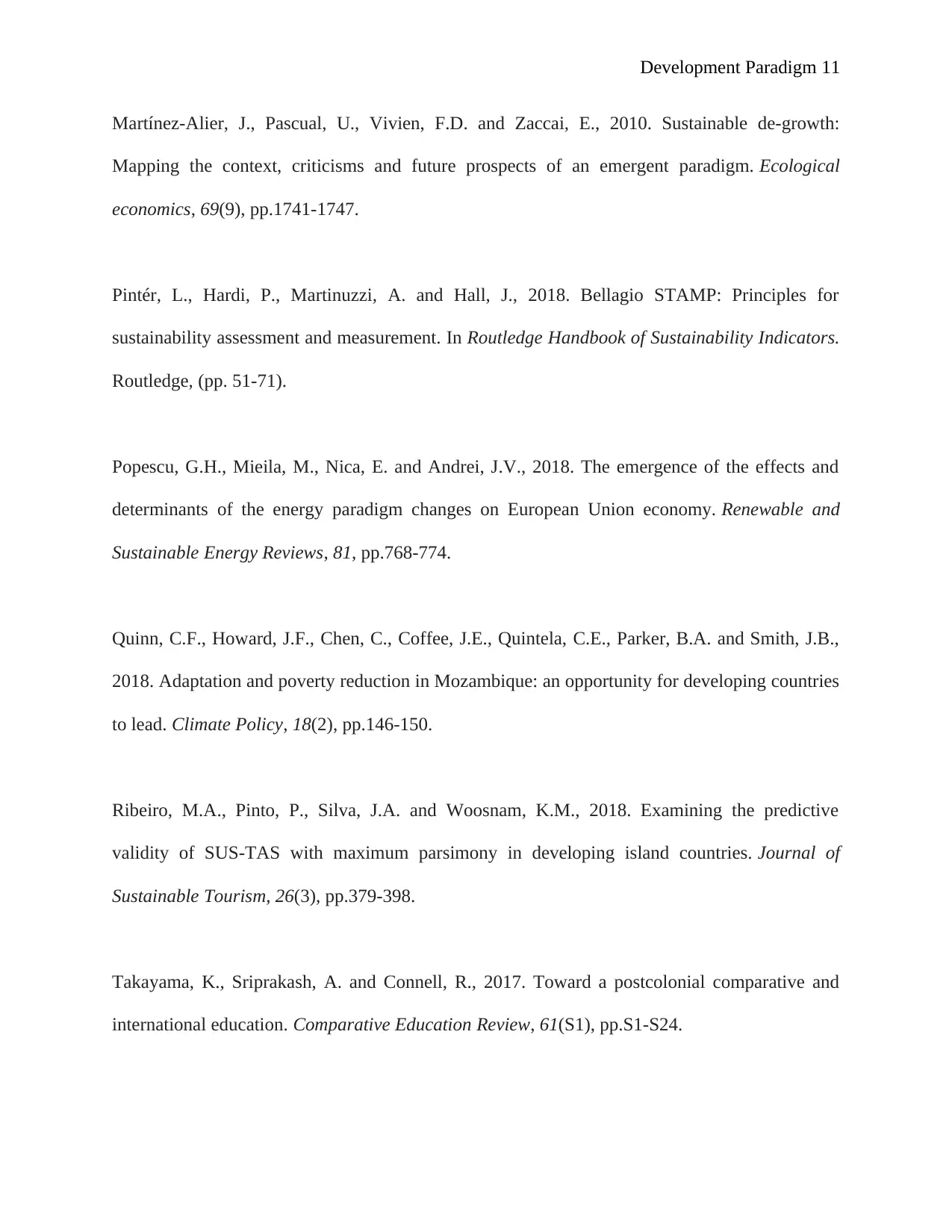
Development Paradigm 11
Martínez-Alier, J., Pascual, U., Vivien, F.D. and Zaccai, E., 2010. Sustainable de-growth:
Mapping the context, criticisms and future prospects of an emergent paradigm. Ecological
economics, 69(9), pp.1741-1747.
Pintér, L., Hardi, P., Martinuzzi, A. and Hall, J., 2018. Bellagio STAMP: Principles for
sustainability assessment and measurement. In Routledge Handbook of Sustainability Indicators.
Routledge, (pp. 51-71).
Popescu, G.H., Mieila, M., Nica, E. and Andrei, J.V., 2018. The emergence of the effects and
determinants of the energy paradigm changes on European Union economy. Renewable and
Sustainable Energy Reviews, 81, pp.768-774.
Quinn, C.F., Howard, J.F., Chen, C., Coffee, J.E., Quintela, C.E., Parker, B.A. and Smith, J.B.,
2018. Adaptation and poverty reduction in Mozambique: an opportunity for developing countries
to lead. Climate Policy, 18(2), pp.146-150.
Ribeiro, M.A., Pinto, P., Silva, J.A. and Woosnam, K.M., 2018. Examining the predictive
validity of SUS-TAS with maximum parsimony in developing island countries. Journal of
Sustainable Tourism, 26(3), pp.379-398.
Takayama, K., Sriprakash, A. and Connell, R., 2017. Toward a postcolonial comparative and
international education. Comparative Education Review, 61(S1), pp.S1-S24.
Martínez-Alier, J., Pascual, U., Vivien, F.D. and Zaccai, E., 2010. Sustainable de-growth:
Mapping the context, criticisms and future prospects of an emergent paradigm. Ecological
economics, 69(9), pp.1741-1747.
Pintér, L., Hardi, P., Martinuzzi, A. and Hall, J., 2018. Bellagio STAMP: Principles for
sustainability assessment and measurement. In Routledge Handbook of Sustainability Indicators.
Routledge, (pp. 51-71).
Popescu, G.H., Mieila, M., Nica, E. and Andrei, J.V., 2018. The emergence of the effects and
determinants of the energy paradigm changes on European Union economy. Renewable and
Sustainable Energy Reviews, 81, pp.768-774.
Quinn, C.F., Howard, J.F., Chen, C., Coffee, J.E., Quintela, C.E., Parker, B.A. and Smith, J.B.,
2018. Adaptation and poverty reduction in Mozambique: an opportunity for developing countries
to lead. Climate Policy, 18(2), pp.146-150.
Ribeiro, M.A., Pinto, P., Silva, J.A. and Woosnam, K.M., 2018. Examining the predictive
validity of SUS-TAS with maximum parsimony in developing island countries. Journal of
Sustainable Tourism, 26(3), pp.379-398.
Takayama, K., Sriprakash, A. and Connell, R., 2017. Toward a postcolonial comparative and
international education. Comparative Education Review, 61(S1), pp.S1-S24.
1 out of 11
Your All-in-One AI-Powered Toolkit for Academic Success.
+13062052269
info@desklib.com
Available 24*7 on WhatsApp / Email
![[object Object]](/_next/static/media/star-bottom.7253800d.svg)
Unlock your academic potential
© 2024 | Zucol Services PVT LTD | All rights reserved.

